
Swallow is a small village and civil parish in the West Lindsey district of Lincolnshire, England, on the A46 road 4 miles (6.4 km) north-east from Caistor. The population taken at the 2011 census was 289.

Chiddingfold is a village and civil parish in the Weald in the Waverley district of Surrey, England. It lies on the A283 road between Milford and Petworth. The parish includes the hamlets of Ansteadbrook, High Street Green and Combe Common.

A cottage, during England's feudal period, was the holding by a cottager of a small house with enough garden to feed a family and in return for the cottage, the cottager had to provide some form of service to the manorial lord. However, in time cottage just became the general term for a small house. In modern usage, a cottage is usually a modest, often cosy dwelling, typically in a rural or semi-rural location and not necessarily in England. The cottage orné, often quite large and grand residences built by the nobility, dates back to a movement of "rustic" stylised cottages of the late 18th and early 19th century during the Romantic movement.
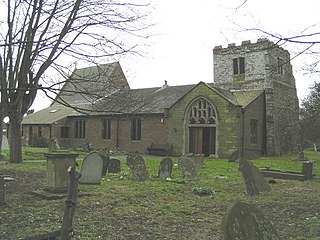
Mablethorpe is a seaside town in the civil parish of Mablethorpe and Sutton, in the East Lindsey district of Lincolnshire, England. The population including nearby Sutton-on-Sea was 12,531 at the 2011 census and estimated at 12,633 in 2019. The town was visited regularly by Alfred, Lord Tennyson, a 19th-century Poet Laureate of the United Kingdom. Some town features have been named after him, such as Tennyson Road and the now closed Tennyson High School.

Nocton is a village and civil parish in the North Kesteven district of Lincolnshire, England. It is situated on the B1202 road, 7 miles (11 km) south-east from Lincoln city centre. The population of the civil parish at the 2011 census was 819. To the east of the village is Nocton Fen with its small settlement of Wasps Nest. To the west of the village, situated at the junction of Wellhead Lane and the B1188 road, is Nocton Top Cottages consisting of eight further dwellings. At the south of the village are the remains of Nocton Hall, and 1 mile (2 km) to the east the earthwork remains of Nocton Park Priory.

Wyberton is a village in Lincolnshire, England. It lies just south-west of Boston, and on the B1397 – the former A16 London Road – between Boston and Kirton. The A16 bisects the village. The population of the civil parish at the 2011 census was 3,747.
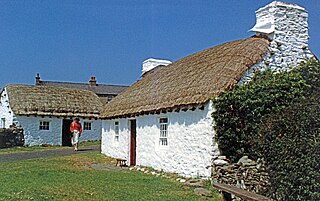
Cregneash or Cregneish is a small village and tourist destination in the extreme south-west of the Isle of Man, about 1 mi (2 km) from Port Erin. Most of the village is now part of a living museum run by Manx National Heritage. There are also a number of private homes in the village, but their external appearance is controlled to maintain an older look. The village was also home to prominent Manx language speakers, Edward Faragher and Ned Maddrell.

Iken is a small village and civil parish in the sandlands of the English county of Suffolk, an area formerly of heathland and sheep pasture. It is near the estuary of the River Alde on the North Sea coast and is located south east of Snape and due north of Orford. To its west is Tunstall Forest, created since the 1920s by the Forestry Commission and now part of the Sandlings Forest.

The Weald and Downland Living Museum is an open-air museum in Singleton, West Sussex. The museum is a registered charity.
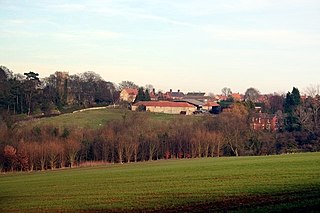
Navenby is a village and civil parish in the North Kesteven district of Lincolnshire, England. Lying 8 miles (13 km) south from Lincoln and 9 miles (14 km) north-northwest from Sleaford, Navenby had a population of 2,128 in the 2011 census and in March 2011, it was named as the 'Best Value Village' in England following a national survey.

Brinkhill is a village and civil parish in the East Lindsey district of Lincolnshire, England. It is situated approximately 5 miles (8 km) west from the market town of Alford and 7 miles (11 km) north-west from Spilsby, The village lies in the Lincolnshire Wolds, a designated Area of Outstanding Natural Beauty.
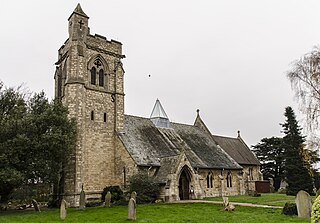
Skellingthorpe is a village and civil parish in the North Kesteven district of Lincolnshire, England. The population of the village at the 2011 census was 3,465. It is situated 3 miles (5 km) west of Lincoln, 4 miles (6 km) southeast of Saxilby, 6 miles (10 km) northwest of North Hykeham and 15 miles (24 km) east of Tuxford.

Fulletby is a village and a civil parish in the East Lindsey district of Lincolnshire, England. It is in the Lincolnshire Wolds, and 3 miles (5 km) north-east from Horncastle, 9 miles (14 km) south from Louth, and 8 miles (13 km) north-west from Spilsby. The parish covers approximately 1,950 acres (8 km2). At the time of the 2011 census the population remained less than 100 and is included in the civil parish of Low Toynton.
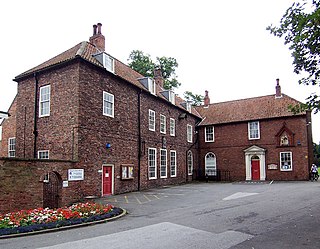
Baysgarth House Museum is a local museum located in Baysgarth House, situated in Baysgarth Park, in the market town of Barton-upon-Humber, Lincolnshire, England.

High Toynton is a village and civil parish in the East Lindsey district of Lincolnshire, England. It is situated approximately 1.5 miles (2.4 km) east from the town of Horncastle, and in the Lincolnshire Wolds, a designated Area of Outstanding Natural Beauty.

Wood Enderby is a village and civil parish in the East Lindsey district of Lincolnshire, England. It is situated approximately 4 miles (6 km) south from Horncastle. The civil parish includes the hamlets of Cluxby Puckacre and Wilksby.

Thimbleby is a village and civil parish in the East Lindsey district of Lincolnshire, England. It is situated approximately 1 mile (1.6 km) west from the A158 road and the town of Horncastle.
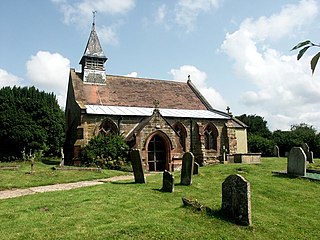
Hameringham is an extended village in the East Lindsey district of Lincolnshire, England. It is situated 4 miles (6.4 km) south-east from the town of Horncastle, and consists of High Hameringham and Low Hammeringham. It is in the civil parish of Lusby with Winceby.

Langton by Spilsby, sometimes called Langton by Partney, is a village and civil parish in the East Lindsey district of Lincolnshire, England. It is situated approximately 4 miles (6 km) north from the town of Spilsby, Lincolnshire. The civil parish includes the hamlet of Sutterby. From the 2011 census the population is included in the civil parish of Sausthorpe.

West Rasen is a village and civil parish in the West Lindsey district of Lincolnshire, England. It is situated on the A631 road, and approximately 3 miles (5 km) west from Market Rasen.





















